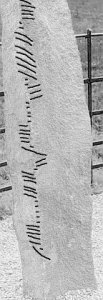For the locality and discovery, cf. {197}.
According to Brash, OIM 233 and Macalister, CIIC, this was the fourth lintel stone in the souterrain.
When visited in 1884, the "head of" this stone could not be inspected by J. Rhys (JRSAI 16, 1884, 314).
Size according to Macalister, CIIC: 4'8" x 1'0" x 0'7"
Published draft:
Macalister, CIIC 1, 194 ( draft).
draft).
First angle:
ᚋᚐᚊᚔᚈᚈᚐᚂᚋᚐᚊᚃᚑᚏᚌᚑᚄᚋᚐᚊ
MAQITTALMAQIFORGOSMAQ
MAQI TTAL MAQI FORGOS MAQI
"The last letter is close to the top and is partially on the head of the stone, but partly concealed by the masonry".
Second angle (opposite):
ᚑᚔᚈᚑᚔᚉᚐᚉ
OITOICAC
"I have a strong suspicion that the entire read:"
MAQI TTAL MAQI FORGOS MAQ(I MUC)OI TOICAC
The first name is Dal, TT "at the commencement of a word" having "the power of D". Dal is a prefix in Dallan Forgail, AD 592; Dallan, son of Mor, AD 903; Dalach, AD 818 (Ann. Four Mast.). But in the Maghlena pedigrees, we find TAL (Battle of M., 175). "Forgus is evidently an archaic form of Fergus", cp. Daire McForgo in the Ann.Tig. BC 164 (O'Connor's Rerum Hib., Script.Vet. v. ii.). In "Hiberno-Romanesque" characters it is spelt Forcus it on a stone at St. Vigeans, Forfarshire {P4}). The individual mentioned as Toica is the same as in no. 1 {197}. Both stones could have been "taken from a family or tribal cemetery". Mucoi "would appear to be a title of Toica".
Only the names Tal and Forgos are mentioned.
ᚋᚐᚊᚔᚈᚈᚐᚂᚋᚐᚊᚔᚃᚑᚏᚌᚑᚄᚋᚐᚊᚔᚋᚒᚉᚑᚔᚈᚑᚑᚉᚐᚉ
MAQITTALMAQVORGOSMAQIMUCOITOICAC
A derivative of Ttal is met with in the form Talagni in Emalough West {181}; Tal appears in the `Battle of Magh Lena'. Vorgos occurs on "Montaggart IV" {121} "with its proper genitive termination"; this "is of course the well-known Fergus of the chroniclers". - The inscription has a "peculiar construction" being "neither thoroughly Goidelic nor thoroughly agglutinative" because of the changing between forms with and without endings. "The inscription is thus a remarkable example of transition from one linguistic method to another."
Up-top-down:
MAQI-TTAL MAQI VORGOS MAQI MUCOI TOICAC
"The second I of the last word was never on the stone: it has been omitted by the lapidary".
MAQI TTAL MAQI VORGOS MAQI MUCOI TOICAC
The inscription is very well preserved. It is anachronistic in that it contains the desinential S in an -i-stem noun but also endingless -o-stem nouns; cp. {172}. It has to be dated into the 1st half of the 6th cent.
MAQI-TTAL MAQI VORGOS MAQI MUCOI TOICAC
Reading Gippert (1978/1981):
 Dexter angle up -
Dexter angle up -  top -
top -  sinister angle down:
sinister angle down:
MAQITTAL MAQI VORGOS MAQI MU(C)OI TOICAC
ᚋᚐᚊᚔᚈᚈᚐᚂᚋᚐᚊᚔᚃᚑᚏᚌᚑᚄᚋᚐᚊᚔᚋᚒ/ᚉ)ᚑᚔᚈᚑᚑᚉᚐᚉ
ᚋᚐᚆᚆᚆᚆᚆᚐᚐᚐᚐᚐᚆᚆᚆᚆᚆᚆᚐᚁᚁᚋᚐᚆᚆᚆᚆᚆᚐᚐᚐᚐᚐᚁᚁᚁᚐᚐᚋᚋᚋᚋᚋᚋᚋᚐᚐᚁᚁᚁᚁᚋᚐᚆᚆᚆᚆᚐᚐᚐᚐᚐᚋᚐᚐᚐᚆᚆᚆ(ᚆ)ᚐᚐᚐᚐᚐᚐᚐᚆᚆᚆᚐᚐᚐᚐᚐᚐᚐᚆᚆᚆᚆᚐᚆᚆᚆᚆ
 draft).
draft). Dexter angle up -
Dexter angle up -  top -
top -  sinister angle down:
sinister angle down: